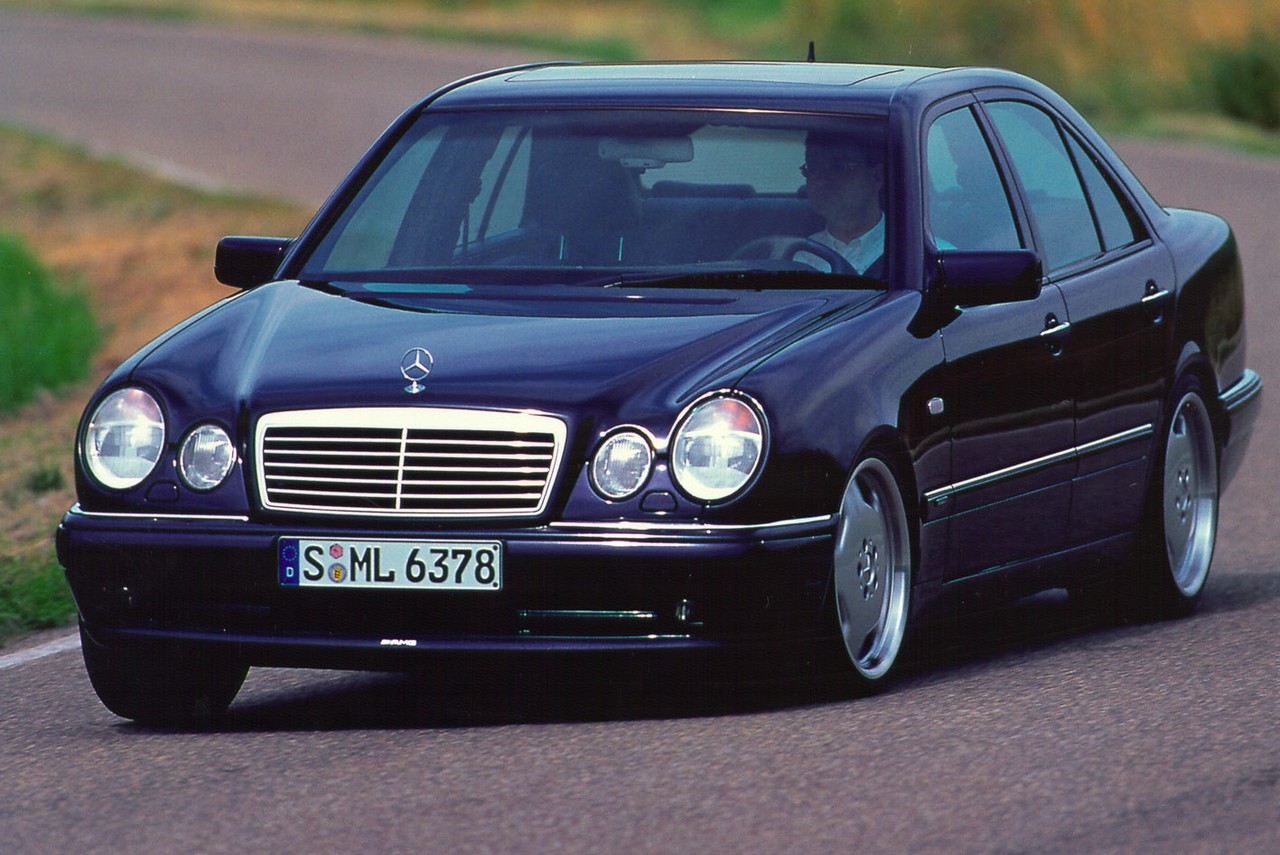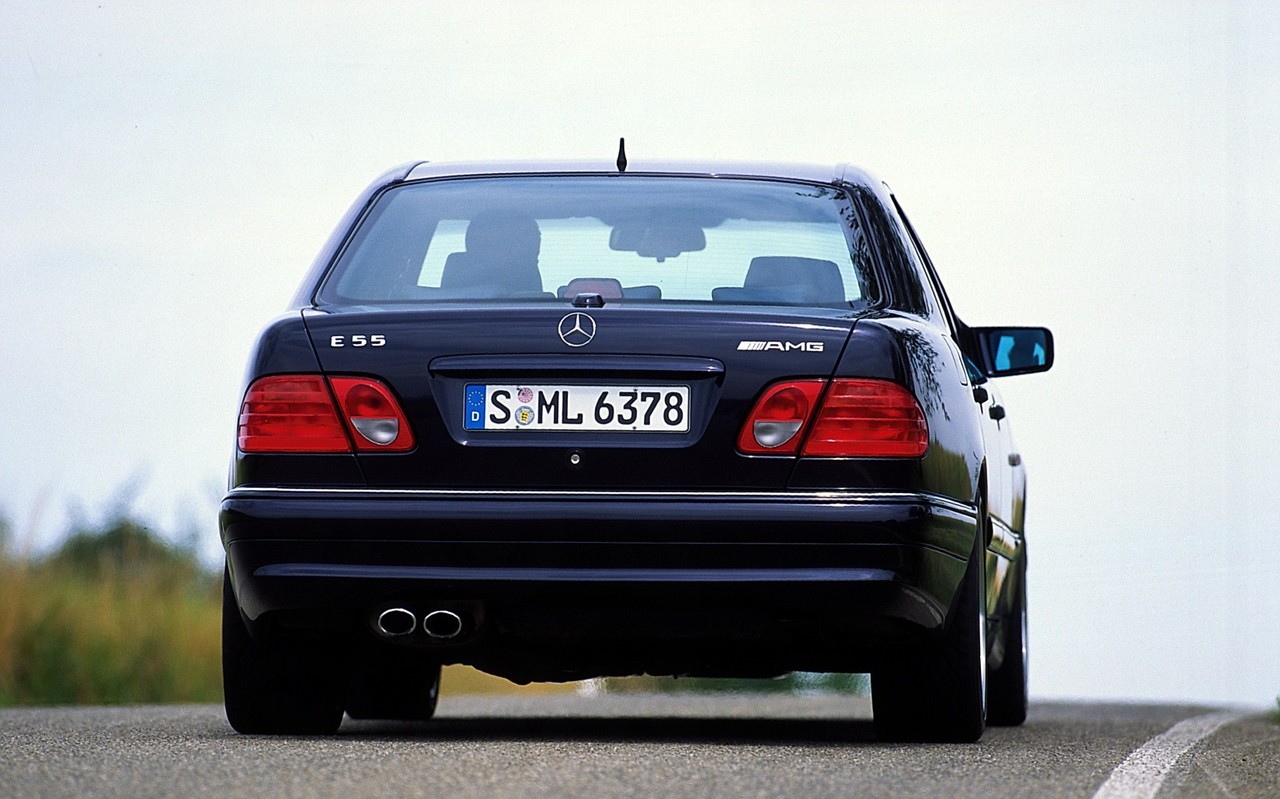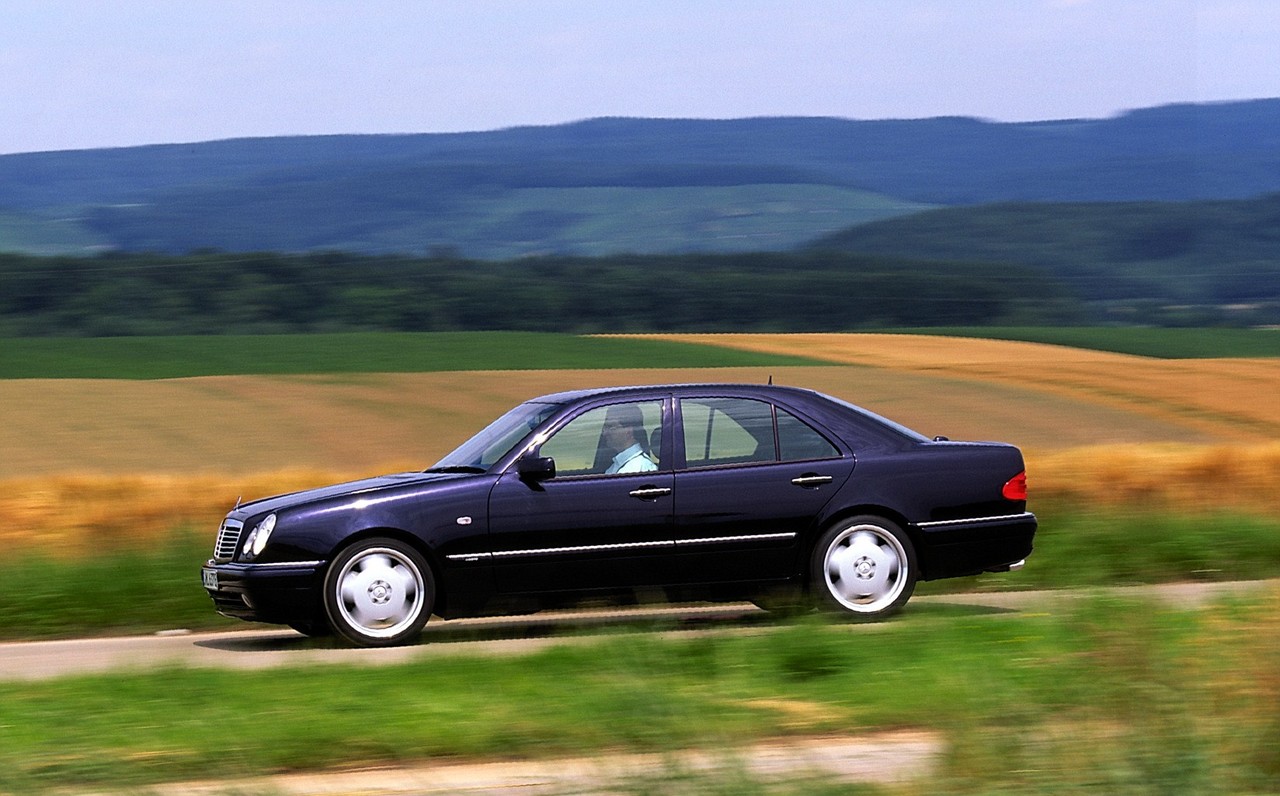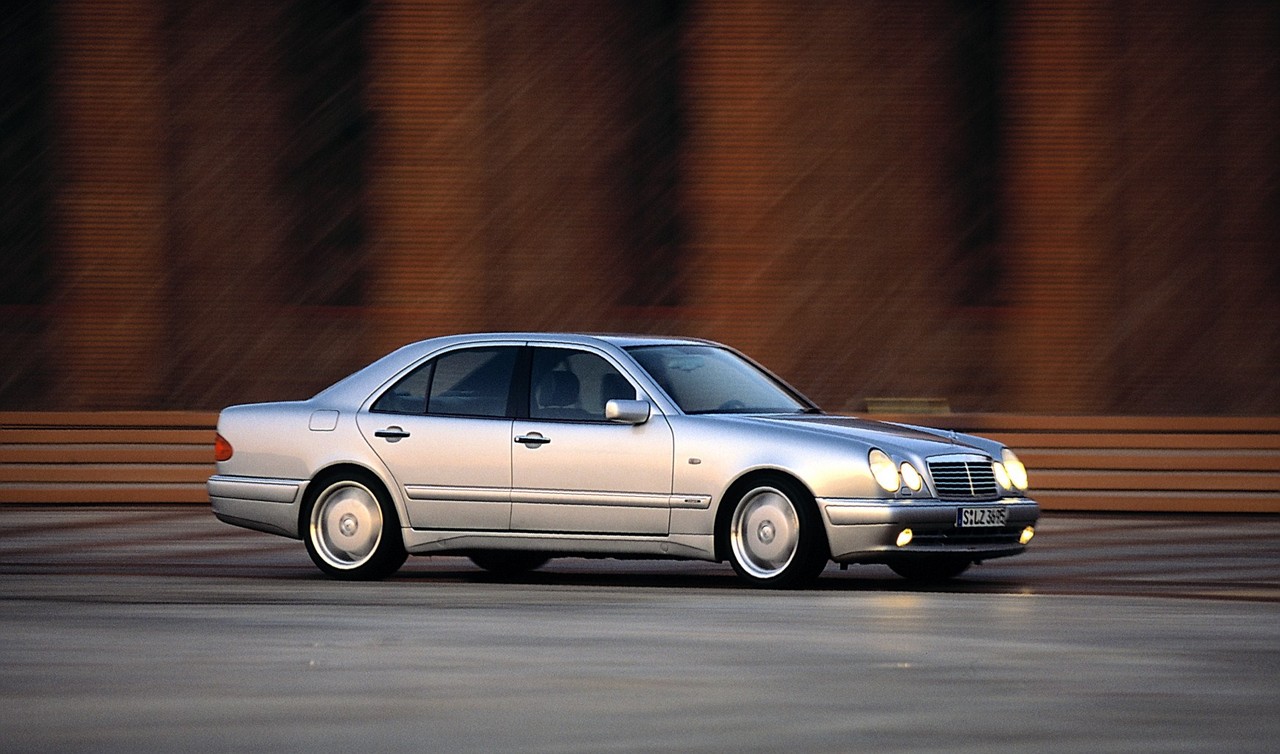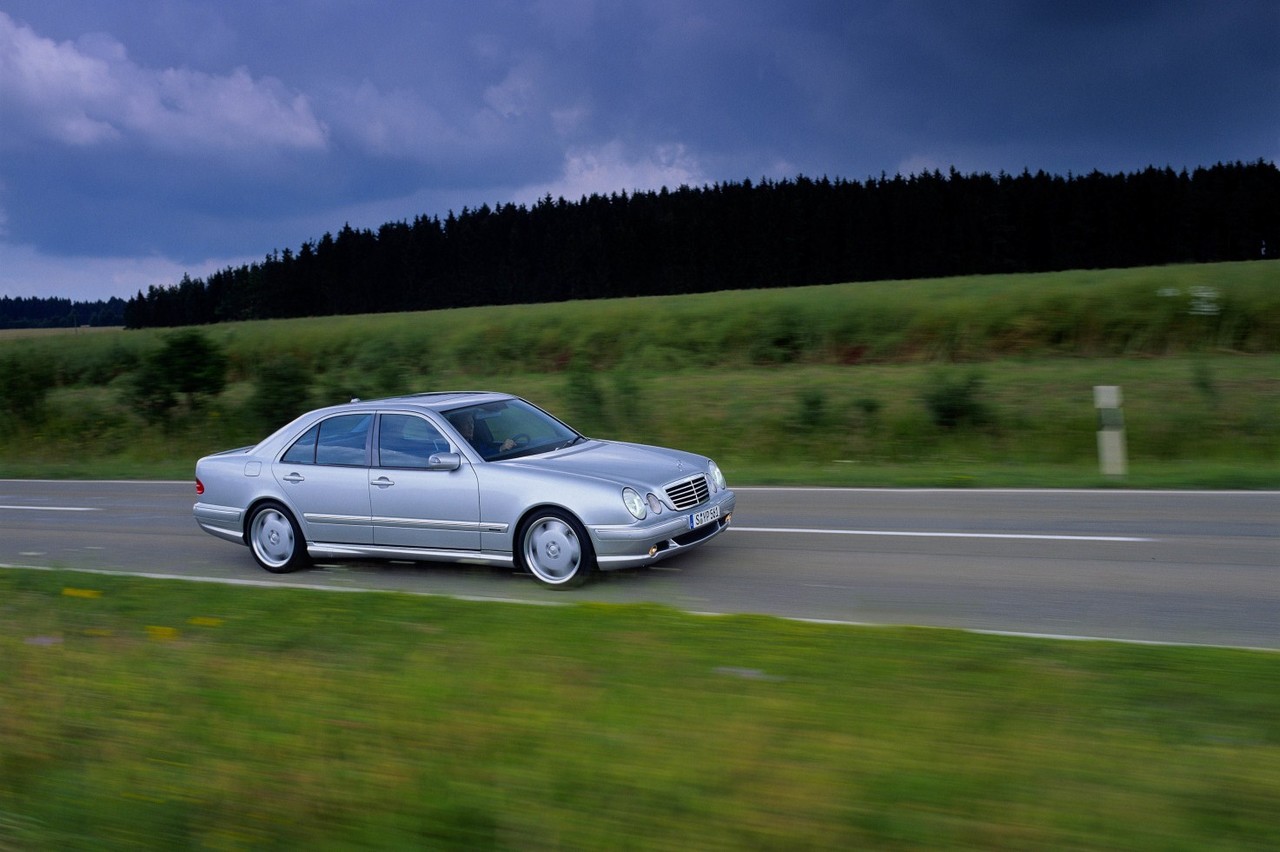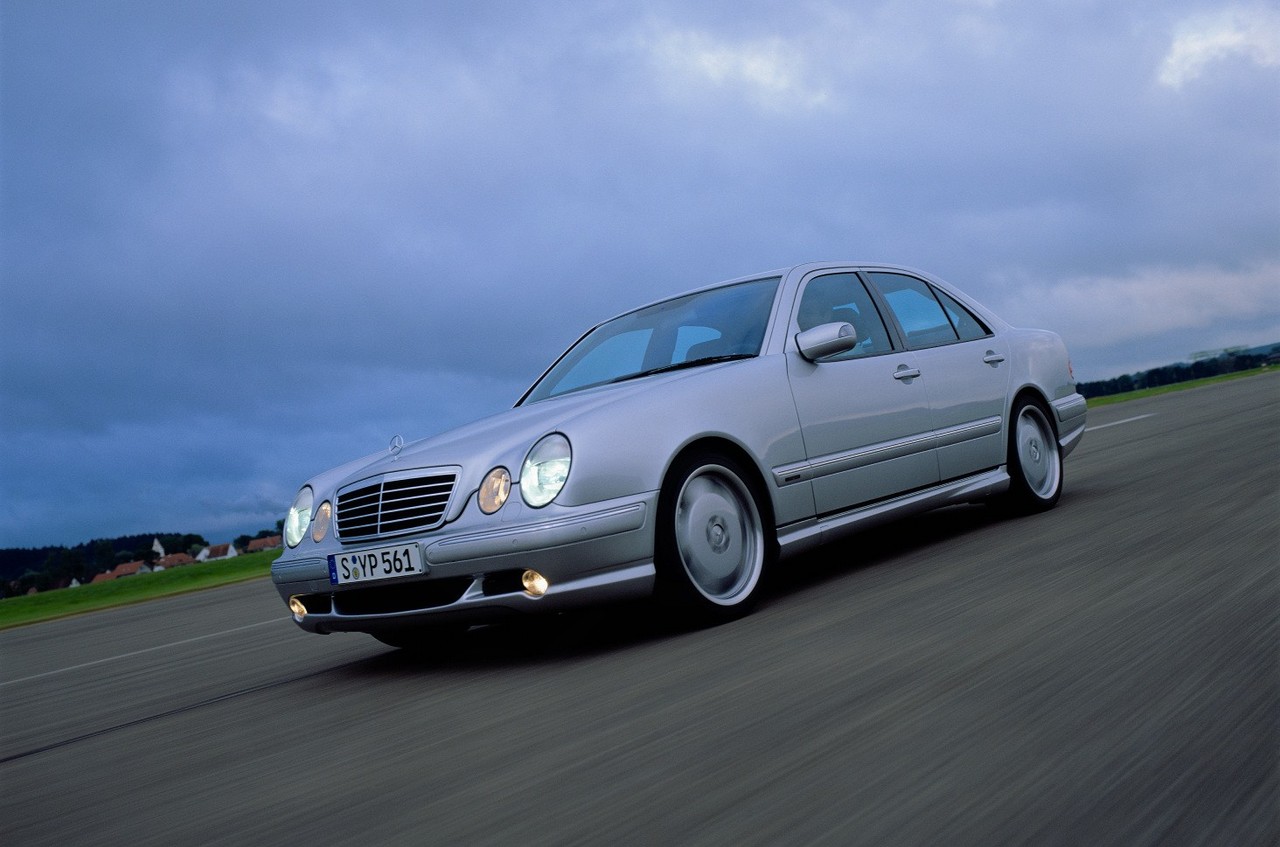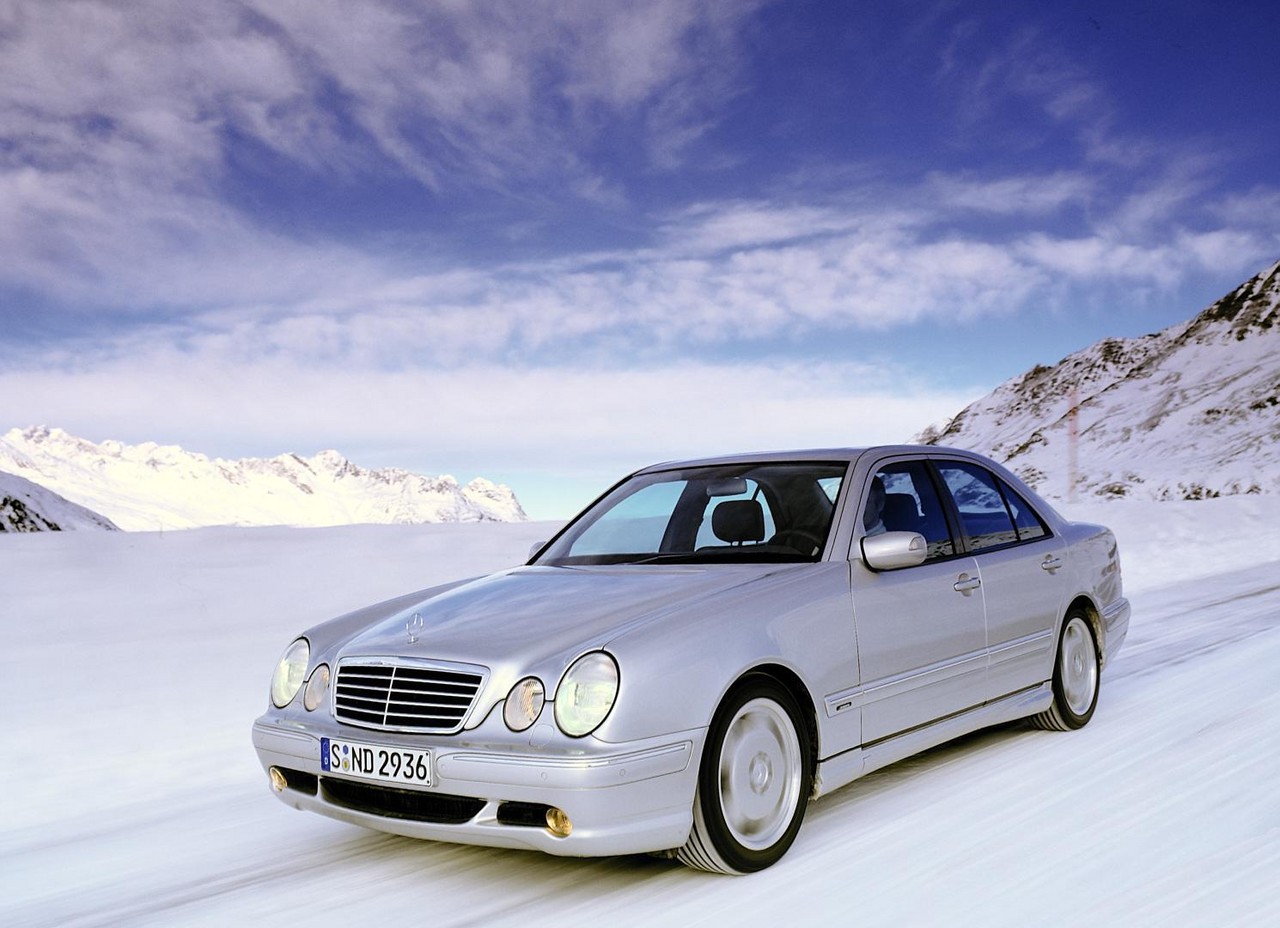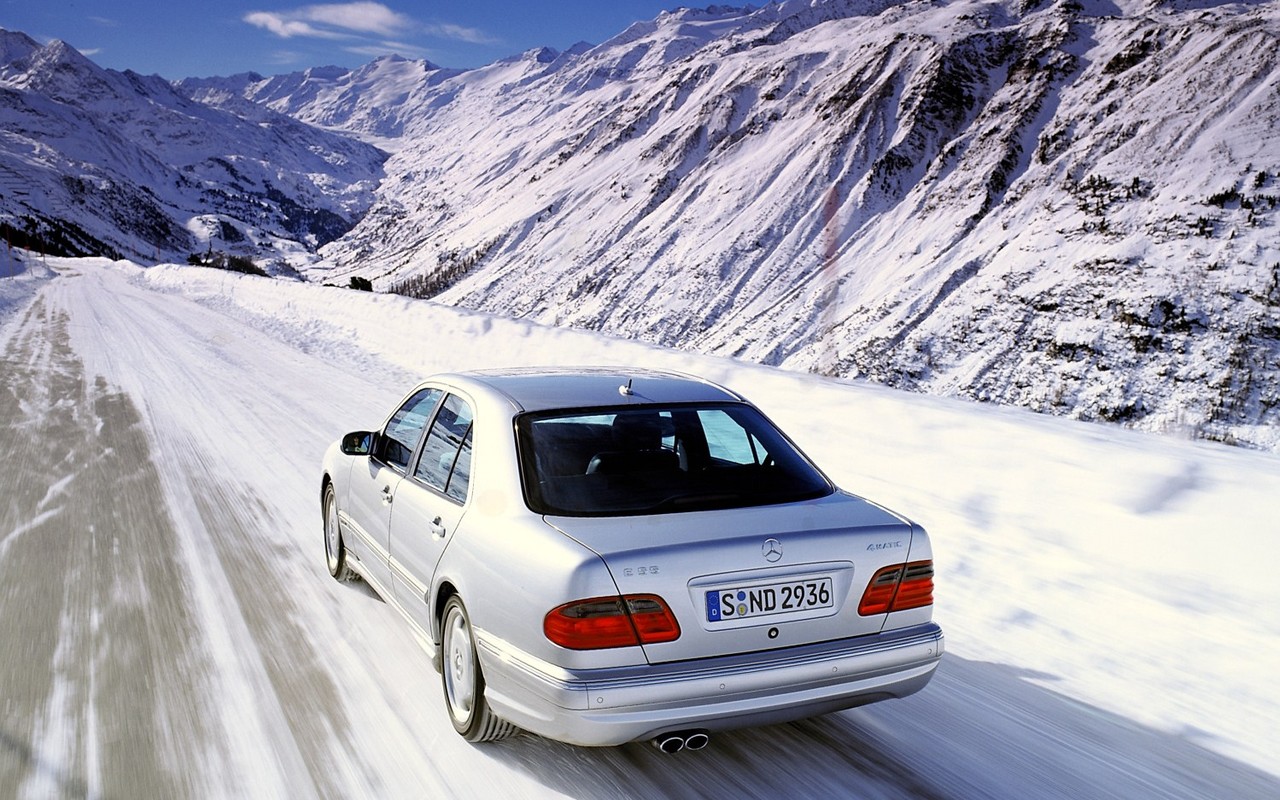
- For E 55 AMG, powerful M113 V8 engine
- Impressive ride/handling balance
- Body feels solid and rigid
- Accurate steering provides good feedback
- Firm, front leather seats can be slippery
- For E 36 AMG, 3.6-litre M104 engine is eager, but not that quick
Mercedes W210.I E 36 AMG and E 55 AMG (1996-99)
Overview
Released in Australia in May 1996, the Mercedes-Benz W210 E 36 AMG was an executive sedan. Manufactured by hand at Mercedes-Benz Affalterbach plant in Germany, the rear-wheel drive E 36 AMG was powered by a 3.6-litre inline six cylinder petrol engine that was mated to a four-speed automatic transmission. Production of the W210 E 36 AMG was discontinued in March 1997 – less than 400 E 36 AMG vehicles are understood to have been produced, with only 49 delivered to Australia.
In April 1998, the E 55 AMG was released – it was powered by a 5.4-litre V8 petrol engine that was mated to a five-speed automatic transmission.
E 36 AMG: M104.941 engine
For the E 36 AMG, the 3606 cc M104.941 engine had a cast iron block with a 92.4 mm stroke and 91.0 mm bores, an alloy cylinder head, a hot film mass airflow sensor and sequential fuel injection (HFM-SFI), double overhead camshafts (chain-driven), a variable intake camshaft which could advance the camshaft by 32 degrees, four valves per cylinder actuated by hydraulic bucket tappets, coil pack ignition and a compression ratio of 10.5:1.
Compared to the standard 2.8-litre M104 engine, changes for the M104.941 AMG engine included:
- Aluminium-forged pistons with shorted skirts;
- A finely balanced crankshaft that was adapted from the 3.5-litre OM603 engine;
- A larger intake cross-over pipe;
- free-flowing exhaust;
- A unique intake camshaft;
- Modified HFM-SFI engine management (Motronic M 3.4.2); and,
- Sodium-cooled exhaust valves.
The E 36 AMG could accelerate from rest to 100 km/h in 6.7 seconds.
E 55 AMG: M113.980 engine
For the E 55 AMG, the 5439 cc M113.980 V8 engine had a die-cast alloy block with 97.0 mm bores and a 92.0 mm stroke, cast-in Silitec cylinder liners, fracture-split forged steel connecting rods, iron-coated aluminium pistons with oil spray cooling, an alloy cylinder head, a single overhead camshaft (SOHC) per cylinder bank driven by a double-roller chain, three valves per cylinder (two intake, one exhaust) actuated by roller rockers, two-spark plugs per cylinder, a dual-length intake manifold and a compression ratio of 10.5:1.
For the five-speed automatic transmission (part code 722.6), the transmission ratios were 3.59 (1st), 2.19 (2nd), 1.41 (3rd), 1.00 (4th) and 0.83 (5th), while the final drive ratio was 2.82. Furthermore, the E 55 AMG had a 6000 rpm redline and could accelerate from rest to 100 km/h in 5.7 seconds.
| Engine | Trans. | Year | Peak power | Peak torque | |
|---|---|---|---|---|---|
| E 36 AMG | 3.6-litre petrol I6 (M104) | 4sp auto | 1996-97 | 200 kW at 5500 rpm | 380 Nm at 4000-4750 rpm |
| E 55 AMG | 5.4-litre petrol V8 (M113) | 5sp auto | 1998-99 | 260 kW at 5500 rpm | 530 Nm at 3000 rpm |
Dimensions
The Mercedes-Benz W210 E 36 and E 55 AMG were 4795 mm long, 1799 mm wide (excluding mirrors), 1411 mm tall and had 2833 mm long wheelbases; boot capacity was 520 litres. While the E 36 AMG had a kerb weight of 1610 kg, the E 55 AMG weighed 1710 kg.
Compared to W210 E-Class , the E 36 AMG and E 55 AMG could be identified by their AMG body kits which include unique front and rear aprons, integrated front fog lamps and side skirts.
Suspension
The Mercedes-Benz E 36 AMG and E 55 AMG had double wishbone front suspension and five-link rear suspension, both with coil springs, gas-pressure shock absorbers and torsion-bar stabilisers.
Steering
Both the Mercedes-Benz E 36 AMG and E 55 AMG had rack-and-pinion, power-assisted steering. For the E 55 AMG, however, Mercedes-Benz’s speed-sensitive ‘parameter steering’ was fitted as standard.
Safety equipment
Standard safety equipment for the Mercedes-Benz W210 E 36 AMG included dual front airbags, ABS, traction control (Mercedes-Benz’s ‘Electronic Traction Support’ or ETS) and front seatbelts with pre-tensioners and load limiters.
From November 1996, the E 36 AMG was fitted with front side airbags as standard; the E 55 AMG was fitted with front side airbags upon its release in April 1998.
In June 1997, standard safety equipment was extended to include brake assist which could detect an emergency stopping situation and automatically boost pedal pressure to reduce braking distances. At this time, the ETS was replaced with Mercedes-Benz’s Acceleration Skid Control (or ASR) traction control system. In addition to reducing engine torque, the ASR system also applied brake pressure to the rear wheels at the commencement of wheel-slip. The ASR system also operated at all vehicle speeds, whereas ETS only operated at up to 40 km/h.
The E 55 AMG was also fitted with electronic stability control as standard.
Brakes: E 55 AMG
The E 55 AMG had two-piece 334 mm by 32 mm vented front brake discs and one-piece 300 mm by 22 mm vented rear discs.
Euro NCAP crash testing
In Euro NCAP crash testing , a 1998 Mercedes-Benz W210 E 200 received a three star adult occupant protection rating with a score of 25.7. For the post-November 1999 W210.II E-Class models, however, a four star rating was conferred due to the fitment of curtain airbags.
In the offset crash test, foot protection and lower leg protection were rated as poor marginal, respectively, due to the extent of brake pedal movement. Furthermore, protection for the driver’s chest in the side impact test was rated as marginal.
Features: Mercedes-Benz E 36 AMG
Standard features for the Mercedes-Benz W210 E 36 AMG included 18-inch light alloy wheels, an eight speaker sound system with a ten-disc CD changer, air conditioning, power adjustable front seats with driver’s seat memory settings, leather upholstery, cruise control (Mercedes-Benz’s ‘Tempomat’), xenon headlights with dynamic range control, front fog lights, an AMG leather-wrapped steering wheel, remote central locking, power windows and mirrors, a power sunroof, AMG instrument cluster with ivory-coloured dials, Bird’s eye maple wood veneers and an immobiliser.
Features: Mercedes-Benz E 55 AMG
Compared to the E 36 AMG, standard features for the Mercedes-Benz E 55 AMG were extended to include climate control air conditioning and a power adjustable steering column; the power-operated sunroof, however, was optional. However, the E 55 AMG incorporated changes from the W210 E-Class that were introduced in June 1997, such as:
- Mercedes-Benz’s ‘Speedtronic’ cruise control (replacing ‘Tempomat’) which could be applied at any speed above 30 km/h and varied by 10 km/h increments;
- Mercedes-Benz’s electronic and driver authorization system, ELCODE. The ELCODE system replaced the mechanical ignition key with an electronic unit which automatically started the engine once the key was inserted into the ignition/starter switch; and,
- Mercedes-Benz’s Active Service System, ASSYST). ASSYST monitored oil condition to determine when the vehicle needed to be serviced, providing this information via a digital display in the instrument binnacle.
The E 55 AMG had 8.0J x 18inch front alloy wheels with 235/40 ZR18 front tyres and 9.0J x 18-inch rear alloy wheels with 265/35 ZR18 rear tyres.
Review: Mercedes W210.II E 55 AMG sedan (1999-02)
Overview
Released in November 1999, the Mercedes-Benz W210 Series II (W210.II) E 55 AMG was fitted with additional safety equipment, a ‘tip’ or sequential shift function for the automatic transmission and revised suspension. Visually, the W210.II E 55 AMG could be identified by its 20 mm lower front wings and lower bonnet, 15 mm lower headlights, revised radiator grille, body-integrated bumpers with redesigned air intakes and fog lamps, indicators integrated in the door mirror housings and new tail-lights.
Inside, there was a new instrument cluster with a central display, ‘Audio 10’ sound system, new fabrics and trim, an updated centre console, interior lighting, a multi-function steering wheel from the W220 S-Class and pneumatically-folding rear headrests. For greater refinement, the W210.II E 55 AMG had thicker velour trims for the door pillars and roof lining, and thicker carpeting for the footwells.
For the Mercedes-Benz W210.II E 55 AMG, the rear suspension was revised with the fitment of AMG-Bilstein gas-pressurised shock absorbers, progressive-rate coil springs and thicker stabiliser bars.
| Engine | Trans. | Peak power | Peak torque | |
|---|---|---|---|---|
| E 55 AMG | 5.4-litre petrol V8 (M113) | 5sp auto | 260 kW at 5500 rpm | 530 Nm at 3000 rpm |
Safety equipment
Standard safety equipment for the Mercedes-Benz W210.II E 55 AMG was extended to include full-length curtain airbags and rear side airbags.
Features: Mercedes-Benz E 55 AMG
Compared to its W210.I predecessor, standard features for the Mercedes-Benz W210.II E 55 AMG were extended to include two-tone leather upholstery, heated front seats, 1/3 to 2/3 split and folding rear seats, and a power-operated glass sunroof; the ten-disc CD changer, however, was replaced by a six-disc changer.
Related links
